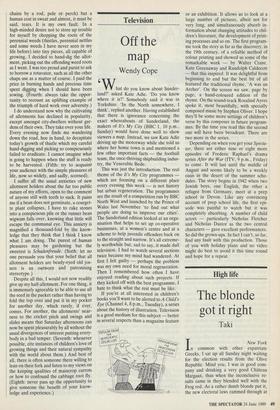Television
Off the map
Wendy Cope
What do you know about Sunder- land?' asked Kate Adie. 'Do you know where it is?' Somebody said it was in Yorkshire. 'In the North somewhere, I think', replied another. Having established that there is ignorance concerning the exact whereabouts of Sunderland, the makers of It's My City (BBC 1, 10 p.m., Sunday) would have done well to show viewers a map. Instead, we saw Kate Adie driving up the motorway while she told us where her home town is and mentioned a few other important facts — the football team, the once-thriving shipbuilding indus- try, the Venerable Bede.
This was just the introduction. The real theme of the It's My City programmes which are focusing on a different place every evening this week — is not history but urban regeneration. The programmes are the result of a competition run by BBC North West and launched by the Prince of Wales last November 'to find out what people are doing to improve our cities'. The Sunderland edition looked at an orga- nisation that helps to set up co-operative businesses, at a women's centre and at a scheme to help juvenile offenders back on to the straight and narrow. It's all extreme- ly worthwhile but, sad to say, it made dull television. I had to watch several sections twice because my mind had wandered. At first I felt guilty — perhaps the problem was my own need for moral regeneration. Then I remembered how often I have enjoyed reading about such projects. If they kicked off with the best programme, I hate to think what the rest must be like.
If you're at all interested in children's books you'll want to be alerted to A Child's Eye (Channel 4, 8 p.m., Tuesday), a series about the history of illustration. Television is a good medium for this subject — better in several respects than a magazine feature or an exhibition. It allows us to look at a large number of pictures, albeit not for very long, and simultaneously absorb in- formation about changing attitudes to chil- dren's literature, the development of print- ing processes and so on. The first program- me took the story as far as the discovery, in the 19th century, of a reliable method of colour printing and showed us some of the remarkable work — by Walter Crane, Kate Greenaway and Randolph Caldecott — that this inspired. It was delightful from beginning to end but the best bit of all featured the traditional rhyme, 'A was an Archer'. On the screen we saw, page by page, a hand-coloured edition of the rhyme. On the sound-track Rosalind Ayres spoke it, most beautifully, with specially composed music by Stephen Oliver. I hope they'll be some more settings of children's verse by this composer in future program- mes. By the time you read this the second one will have been broadcast. There are two more in the series.
Depending on when you get your Specta- tor, there are either nine or eight more episodes of Frederic Raphael's drama series After the War (ITV, 9 p.m., Friday) to come. It will last until the middle of August and seems likely to be a weekly oasis in the desert of the summer sche- dules. The story begins in 1942 when two Jewish boys, one English, the other a refugee from Germany, meet at a prep school in Devon. Like any convincing account of prep school life, the first epi- sode was painful to watch but it was completely absorbing. A number of child actors — particularly Nicholas Fletcher and Nicholas Dastor as the two central characters — gave excellent performances. So did the grown-ups. In fact I can't, so far, find any fault with this production. Those of you with holiday plans and no video might do best to avoid it this time round and hope for a repeat.










































































 Previous page
Previous page